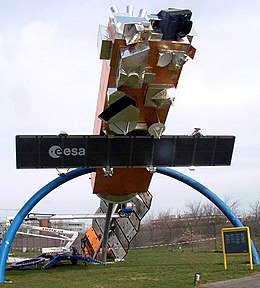ENVISAT

Model of Envisat
|
|
| Mission type | Earth observation |
|---|---|
| Operator | ESA |
| COSPAR ID | 2002-009A |
| SATCAT № | 27386 |
| Website | envisat |
| Mission duration | Planned: 5 years Final: 10 years, 1 month, 6 days |
| Spacecraft properties | |
| Manufacturer | Astrium |
| Launch mass | 8,211 kg (18,102 lb) |
| Dimensions | 2.5 × 2.5 × 10 m (8.2 × 8.2 × 32.8 ft) |
| Power | 6,500 watts |
| Start of mission | |
| Launch date | 1 March 2002, 01:07:59 UTC |
| Rocket | Ariane 5G V-145 |
| Launch site | Kourou ELA-3 |
| Contractor | Arianespace |
| End of mission | |
| Disposal | Spacecraft failure |
| Last contact | 8 April 2012 |
| Orbital parameters | |
| Reference system | Geocentric |
| Regime | Polar low Earth |
| Semi-major axis | 7,144.9 km (4,439.6 mi) |
| Eccentricity | 0.00042 |
| Perigee | 772 km (480 mi) |
| Apogee | 774 km (481 mi) |
| Inclination | 98.40 degrees |
| Period | 100.16 minutes |
| Repeat interval | 35 days |
| Epoch | 15 December 2013, 03:07:00 UTC |
| Instruments | |
Envisat ("Environmental Satellite") is a large inactive Earth-observing satellite which is still in orbit. Operated by the European Space Agency (ESA), it was the world's largest civilian Earth observation satellite.
It was launched on 1 March 2002 aboard an Ariane 5 from the Guyana Space Centre in Kourou, French Guiana, into a Sun synchronous polar orbit at an altitude of 790 km (490 mi) (± 10 km (6.2 mi)). It orbits the Earth in about 101 minutes, with a repeat cycle of 35 days. After losing contact with the satellite on 8 April 2012, ESA formally announced the end of Envisat's mission on 9 May 2012.
Envisat cost €2.3 billion (including €300 million for 5 years of operations) to develop and launch. The mission is due to be replaced by the Sentinel series of satellites. The first of these, Sentinel 1, has taken over the radar duties of Envisat since its launch in 2014.
Envisat was launched as an Earth observation satellite. Its objective was to service the continuity of European Remote-Sensing Satellite missions, providing additional observational parameters to improve environmental studies.
In working towards the global and regional objectives of the mission, numerous scientific disciplines currently use the data acquired from the different sensors on the satellite, to study such things as atmospheric chemistry, ozone depletion, biological oceanography, ocean temperature and colour, wind waves, hydrology (humidity, floods), agriculture and arboriculture, natural hazards, digital elevation modelling (using interferometry), monitoring of maritime traffic, atmospheric dispersion modelling (pollution), cartography and study of snow and ice.
...
Wikipedia
